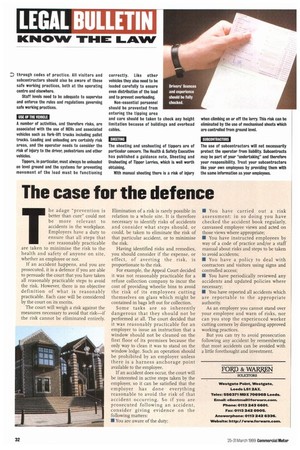11•11 • AT Anyone who comes into contact with the
Page 32

Page 34

If you've noticed an error in this article please click here to report it so we can fix it.
operator's business activities, at the operating centre or elsewhere. This includes; • Members of the public; • Other occupiers of the operating centre and their visitors; • Contractors, cleaners, maintenance staff and visitors, whether employees or not.
WHAT IS THE MU What are the odds of such a risk of injury happening? What precautions are being taken now—and do they need to be tightened up?
There may be legal requirements which deal with the necessary action, either in the form of specific legislation or codes of practice.
Consult your trade association for specific industry standards, and remember if the risk cannot be eliminated, it must be reduced as much as possible.
ME OPERATING CENTRE At any operating centre, vehicles and pedestrians will be moving around the site. and your objective should be
to keep
them apart by setting routes to be taken by vehicles and pedestrians.
Make sure roadways and walkways are clearly marked and consider if warning signs are necessary such as one way" or "no entry".
You might want to fit safety aids such as wall-mounted mirrors and speed humps, and it is sometimes possible to remove obstructions to movement and view for drivers and pedestrians alike.
THE VEHICLE Every operator must ensure that his vehicles are maintained in a fit and serviceable condition at
all times. This requirement under the 0-licence regulations extends to compliance with Heath and Safety legislation. You should also assess the risks associated with the use of that vehicle, This might include fitting of a reversing alarm, but you should also
protect the driver from excess noise, cold and damp, vibration and fumes.
The wise operator uses a forward planning system with a wall planner for preventative maintenance scheduling, annual tests, tachograph calibration and additional checks.
Its also worth setting up a drivers' daily defect reporting system.
THE DINER Drivers and other members of staff are entitled to be trained so that le they can work efficiently to reduce the possibility of risk to themselves and others.
The operator must ensure that he has effectively and properly trained staff, and that his records show this has been done. You should check all drivers' licences and previous experience.
It's sensible to issue written instructions to all drivers and get receipts to prove this has been done. Regular retraining is part of this approach.
The drivers should be made aware of safe working practices as specified by the operator and 0 through codes of practice. All visitors and subcontractors should also be aware of these safe working practices, both at the operating centre and elsewhere.
Staff levels need to be adequate to supervise and enforce the rules and regulations governing safe working practices.
USE OF TNE VEMCLE A number of activities, and therefore risks. are associated with the use of HGVs and associated vehicles such as fork-lift trucks including pallet trucks. Loading and unloading are certainly risk areas, and the operator needs to consider the risk of injury to the driver, pedestrians and other vehicles, Tippers, in particular, must always be unloaded on level ground and the systems for preventing movement of the load must be functioning correctly. Like other vehicles they also need to be loaded carefully to ensure even distribution of the load and to prevent overloading.
Non-essential personnel should be prevented from entering the tipping area and care should be taken to check any height limitation because of buildings and overhead cables.
SHEETING The sheeting and unsheeting of tippers are of particular concern. The Health & Safety Executive has published a guidance note, Sheeting and Unsheeting of Tipper Lorries, which is well worth obtaining.
With manual sheeting there is a risk of injury when climbing on or off the lorry. This risk can be eliminated by the use of mechanised sheets which are controlled from ground level.
SUBCONTRACTORS
The use of subcontractors will not necessarily protect the operator from liability. Subcontracts may be part of your "undertaking" and therefore your responsibility. Treat your subcontractors like your own employees by providing them with the same information as your employees.
















































































































